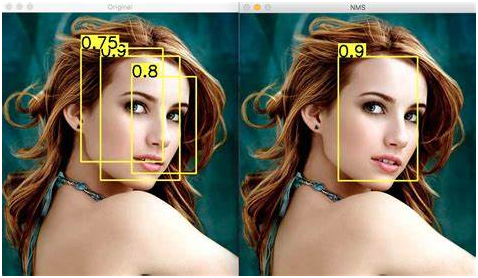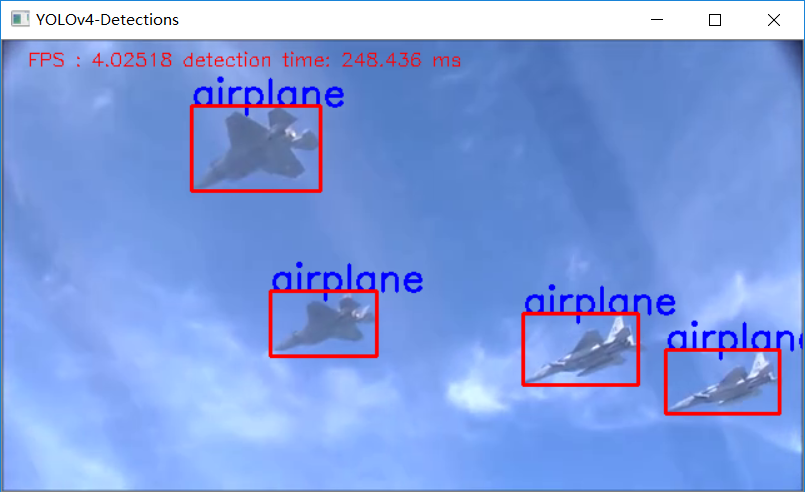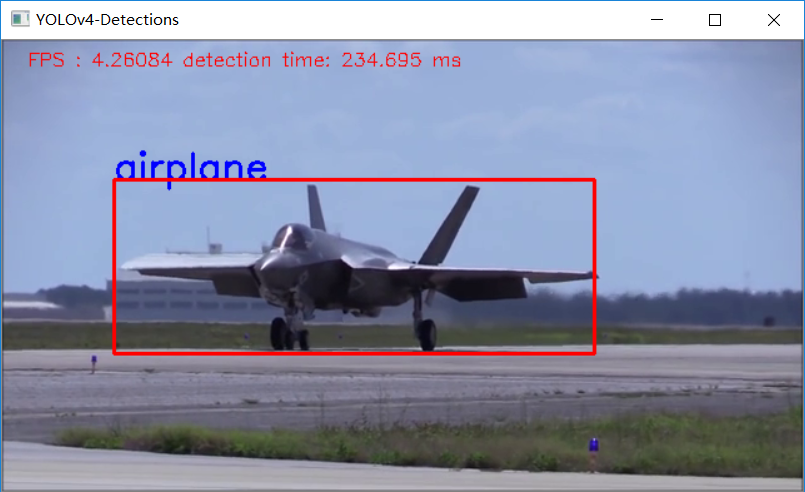OpenCV4.4 + YOLOv4 真的可以运行了…..
点击上方“AI算法与图像处理”,选择加"星标"或“置顶”
重磅干货,第一时间送达
来源:OpenCV学堂
前一阵子YOLOv4发布了,后面就是YOLOv5,估计再过几天就要YOLOv10086了,这个时代技术进步太魔幻,改几个参数就可以继续升级版本。2020.718 OpenCV4.4发布了,支持YOLOv4推理,于是我立刻测试了一波。
YOLOv4的相关模型合集在这里
https://github.com/AlexeyAB/darknet/wiki/YOLOv4-model-zoo我使用的是基于COCO预训练模型:
YOLOv4-Leaky
OpenCV4.4 支持YOLOv4,这个是它的官方release里面说的,其实我早就发现了YOLOv4可以通过OpenCV4.2直接跑,怎么OpenCV4.4才官宣。也许不发布新版本不好官宣,只有发布了新版本才可以顺便说一下。此外OpenCV4.4 DNN还有很多新添加的演示程序,支持了深度学习的光流、支持tensorflow object detection API的EfficientDet对象检测模型,但是前提是tensorflow2.x才可以。多了一个tf_text_graph_efficientdet.py文件,用来生成对应的pbtxt文件。
跟YOLOv3一样,YOLOv4也有三个输出层,完成推理之后,需要在进一步通过NMS实现对重叠框的去除,什么是NMS(非最大抑制),看下图就懂啦:

然后说一下模型输入格式与输出格式
输入:NCHW=1x3x416x416
输出:NXC 其中N表示多少个对象,C的前四个数矩形框的[center_x, center_y, width, height],从第五个数值开始分别是每个类别的得分,求的最大得分,如果高于阈值0.5,则认为检测到了对象,每个score对应的index即是COCO类别文本。
根据上面的描述,对一个视频文件实现YOLOv4的对象检测代码如下:
1Net net = readNetFromDarknet(yolov4_config, yolov4_model);
2net.setPreferableBackend(DNN_BACKEND_INFERENCE_ENGINE);
3net.setPreferableTarget(DNN_TARGET_CPU);
4std::vector outNames = net.getUnconnectedOutLayersNames();
5for (int i = 0; i < outNames.size(); i++) {
6 printf("output layer name : %s\n", outNames[i].c_str());
7}
8
9vector<string> classNamesVec;
10ifstream classNamesFile("D:/projects/opencv_tutorial/data/models/object_detection_classes_yolov3.txt");
11if (classNamesFile.is_open())
12{
13 string className = "";
14 while (std::getline(classNamesFile, className))
15 classNamesVec.push_back(className);
16}
17
18VideoCapture capture;
19capture.open("D:/images/video/f35_02.mp4");
20Mat frame;
21// 加载图像
22while (true) {
23 int64 start = getTickCount();
24 capture.read(frame);
25 Mat inputBlob = blobFromImage(frame, 1 / 255.F, Size(416, 416), Scalar(), true, false);
26 net.setInput(inputBlob);
27
28 // 检测
29 std::vector outs;
30 net.forward(outs, outNames);
31
32 vector boxes;
33 vector<int> classIds;
34 vector<float> confidences;
35 for (size_t i = 0; i36 {
37 // detected objects and C is a number of classes + 4 where the first 4
38 float* data = (float*)outs[i].data;
39 for (int j = 0; j < outs[i].rows; ++j, data += outs[i].cols)
40 {
41 Mat scores = outs[i].row(j).colRange(5, outs[i].cols);
42 Point classIdPoint;
43 double confidence;
44 minMaxLoc(scores, 0, &confidence, 0, &classIdPoint);
45 if (confidence > 0.5)
46 {
47 int centerX = (int)(data[0] * frame.cols);
48 int centerY = (int)(data[1] * frame.rows);
49 int width = (int)(data[2] * frame.cols);
50 int height = (int)(data[3] * frame.rows);
51 int left = centerX - width / 2;
52 int top = centerY - height / 2;
53
54 classIds.push_back(classIdPoint.x);
55 confidences.push_back((float)confidence);
56 boxes.push_back(Rect(left, top, width, height));
57 }
58 }
59 }
60
61 vector<int> indices;
62 NMSBoxes(boxes, confidences, 0.5, 0.2, indices);
63 for (size_t i = 0; i < indices.size(); ++i)
64 {
65 int idx = indices[i];
66 Rect box = boxes[idx];
67 String className = classNamesVec[classIds[idx]];
68 putText(frame, className.c_str(), box.tl(), FONT_HERSHEY_SIMPLEX, 1.0, Scalar(255, 0, 0), 2, 8);
69 rectangle(frame, box, Scalar(0, 0, 255), 2, 8, 0);
70 }
71 float fps = getTickFrequency() / (getTickCount() - start);
72 float time = (getTickCount() - start) / getTickFrequency();
73 ostringstream ss;
74 ss << "FPS : "<< fps <<" detection time: " << time*1000 << " ms";
75 putText(frame, ss.str(), Point(20, 20), 0, 0.5, Scalar(0, 0, 255));
76 imshow("YOLOv4-Detections", frame);
77 char c = waitKey(1);
78 if (c == 27) {
79 break;
80 }
81}
82waitKey(0);
83return; 代码运行结果如下:


我只能说速度有点感人,我有点怕啦,当然我是在i7CPU上运行的。
最后的最后求一波分享!
YOLOv4 trick相关论文已经下载并放在公众号后台
关注“AI算法与图像处理”,回复 “200714”获取
个人微信 请注明:地区+学校/企业+研究方向+昵称 如果没有备注不拉群!

